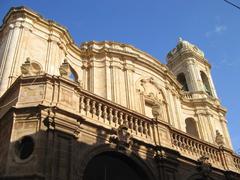Guide to Visiting Porta Trapani in Erice, Italy
Date: 18/07/2024
Introduction
Porta Trapani, a medieval gateway to the enchanting town of Erice in Sicily, Italy, is a historical monument of profound significance. This ancient structure, dating back to the 12th century, stands as a testament to the town’s rich and diverse history. Originally constructed during the Norman rule, Porta Trapani has withstood the test of time, witnessing numerous historical events and transformations. Its architectural grandeur, characterized by robust stone construction and a pointed arch, exemplifies the Gothic style prevalent during the Norman era. As a symbol of Erice’s strategic and cultural importance, this gateway offers visitors a unique glimpse into the past. For more information, visit the official Erice tourism website.
Table of Contents
- Introduction
- Origins and Early History
- Architectural Significance
- Historical Events and Transformations
- Cultural and Symbolic Importance
- Visitor Information
- Special Events and Guided Tours
- Preservation and Modern-Day Significance
- Conclusion
- FAQ
Origins and Early History
Porta Trapani, named after the nearby city of Trapani, dates back to the 12th century during the Norman rule of Sicily. The Normans, known for their architectural prowess, fortified Erice and constructed several gates, including Porta Trapani, to safeguard the town from invasions. Erice itself is believed to have been founded by the Elymians, an ancient people of Sicily, and has seen significant periods under Phoenician, Carthaginian, and Roman control.
Architectural Significance
The gate’s robust stone construction, characterized by a pointed arch, exemplifies the Gothic architectural style typical of the Norman period. Made from local limestone, Porta Trapani blends seamlessly with its surroundings while offering durability. It was part of a larger fortification system designed to withstand sieges and control access to the town.
Historical Events and Transformations
Throughout its history, Porta Trapani has been a witness to numerous historical events. During the 13th century, under Frederick II of Hohenstaufen, the gate was reinforced to withstand evolving siege technologies. In the 15th and 16th centuries, it served as a crucial barrier against Ottoman pirates and other maritime invaders. Periodic repairs and upgrades ensured its defensive capabilities remained intact.
Cultural and Symbolic Importance
Beyond its military significance, Porta Trapani symbolizes the connection between Erice and the surrounding region. Its name reflects the historical ties between Erice and the coastal city of Trapani. This gate facilitated the movement of people, goods, and ideas between these two vital centers, standing as a testament to the resilience and ingenuity of the people who built and defended Erice.
Visitor Information
Visiting Hours
Porta Trapani is accessible to visitors year-round. However, it is advisable to check local sources for the most current visiting hours.
Ticket Prices
Entrance to Porta Trapani is typically free, but additional charges may apply for guided tours or access to nearby attractions.
Travel Tips
Wear comfortable shoes as the cobblestone paths can be uneven. Bring a camera to capture the stunning views from Mount Erice.
Nearby Attractions
While in Erice, don’t miss the Venus Castle, the Balio Gardens, and the Church of San Giovanni. Each site offers a unique glimpse into the town’s historical and cultural legacy.
Accessibility
Porta Trapani is accessible on foot, but the steep climb may be challenging for some visitors. Consider using the cable car from Trapani for a more comfortable ascent.
Special Events and Guided Tours
Erice hosts various cultural events throughout the year, many of which highlight the town’s historical significance. Guided tours are available and provide in-depth insights into Porta Trapani’s history and architecture. Check with local tour operators for schedules and bookings.
Preservation and Modern-Day Significance
Efforts to preserve and restore Porta Trapani have ensured its structural integrity and historical authenticity. Today, it is a prominent tourist attraction, drawing visitors from around the world who come to explore the medieval charm of Erice. Passing through the gate offers a journey back in time, allowing visitors to experience the town’s rich heritage firsthand.
Conclusion
Porta Trapani stands as a remarkable example of medieval military architecture and a symbol of Erice’s historical significance. Its origins, architectural features, and role in historical events highlight its importance as a defensive structure. Moreover, its cultural and symbolic value underscores the deep connections between Erice and the surrounding region. As a preserved historical site, Porta Trapani continues to captivate visitors, offering a glimpse into the town’s rich heritage and enduring legacy.
Frequently Asked Questions (FAQ)
Q: What are the visiting hours for Porta Trapani?
A: Porta Trapani is accessible year-round, but check local sources for the most current visiting hours.
Q: Is there an entrance fee for Porta Trapani?
A: Entrance is typically free, but additional charges may apply for guided tours or access to nearby attractions.
Q: What are some nearby attractions?
A: Nearby attractions include the Venus Castle, Balio Gardens, and the Church of San Giovanni.
Q: How can I get to Porta Trapani?
A: Porta Trapani is accessible on foot, but the climb is steep. The cable car from Trapani offers a more comfortable ascent.
Call to Action
Discover more about Erice and stay updated on upcoming events by downloading the Audiala mobile app. Follow us on social media for the latest updates and travel tips.
